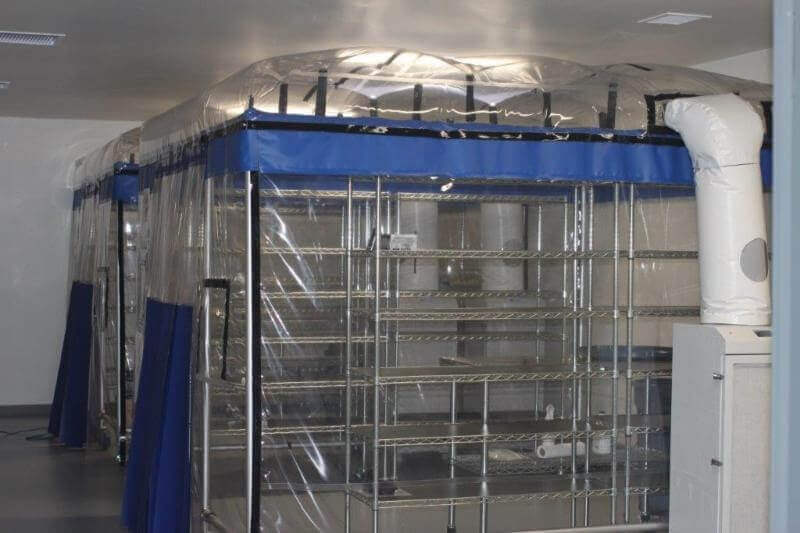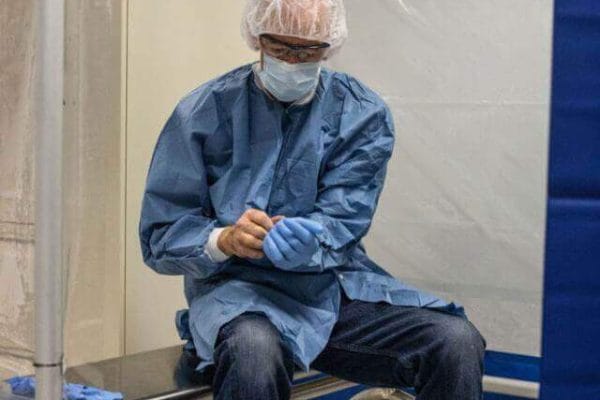bioBUBBLE Cleanrooms for Germ‑Free & Gnotobiotic Mice
bioBUBBLE cleanrooms operate at 75-100 ACH of HEPA-filtered air, 5-6 times more HEPA filtration than a standard room, and are ideal for germ-free and gnotobiotic mice vivariums and other applications. Anterooms and pass-throughs provide a space for sterile gowning and disinfecting incoming materials. Cleanrooms can also dock to germ-free shipping containers and autoclave containers for clean entry into the enclosure.
View sample germ-free cleanroom plans:
Germ-Free Mice
Taconic Germ-Free Mice Housed in Disposable Cages in a bioBUBBLE Cleanroom
by Brittany Dixon, MS
TransPharm Preclinical Solutions
TransPharm Preclinical Solutions is a full-service contract research organization specializing exclusively in microbiology and infectious disease research. We regularly perform efficacy testing of novel antimicrobial therapeutics in mice and rats. Some specialized studies require gnotobiotic, or germ-free, animals. While the average mouse or rat is home to trillions of commensal bacteria and fungi in places like the skin, nose, and gut, gnotobiotic animals are devoid of these microbes.
CARE AND KEEPING OF GNOTOBIOTIC RODENTS
In order to maintain this germ-free condition, the animals’ environment must be carefully controlled. TransPharm uses freestanding bioBUBBLE clean rooms in our vivarium to house gnotobiotic mice. These soft-walled, positive pressure enclosures are attached to energy-efficient motors which allow the bubble to undergo 80-100 air changes per hour of HEPA-filtered air. The walls are made of clear vinyl, allowing visual access without compromising biocontainment, and the entire system is extremely durable. Our bioBubbles® have been in continuous operation for over 11 years.
In addition to being housed in clean rooms, strict husbandry protocols are enforced. Everything that comes into contact with gnotobiotic animals must be sterile. Germ-free animals are caged in Research-Ready™ disposable Innocages®. These clear, strong, lightweight cages are irradiated and also contain irradiated bedding. Animals are fed an irradiated diet and acidified water to avoid the introduction of microbes. Further, research scientists must wear extensive personal protection equipment (PPE) to prevent contamination. Our scientists wear a disposable Tyvek® suit, hairnet, and respirator as well as goggles, gloves, sleeves, and shoe covers. Animals are only handled with autoclaved tweezers to maintain sterility.
Before and after studies, empty bioBUBBLE and study supplies are sterilized using a HaloFogger®. This device transforms a liquid, non-toxic disinfectant into a fine mist of ionized particles that are distributed throughout the bubble, disinfecting every exposed surface.
RESEARCH USING GNOTOBIOTIC RODENTS
Research on germ-free animals began in the 1940s to understand how microorganisms contribute to physiology and disease. Using gnotobiotic animals for specialized studies allows scientists the ability to introduce just one or a few microorganisms and study them in a simpler environment, without the complex microbiome of a conventional animal. For example, the skin microbiome is known to be a contributing factor when evaluating susceptibility to dermal infections. By inoculating germ-free mice with specific bacterial strains, researchers have been able to determine which isolates protect against colonization of certain pathogens. TransPharm Preclinical Solutions has validated Escherichia coli and Clostridium difficile in gastrointestinal infection models using germ-free mice, and additional validations are available upon request. Contact us today for more information or to request a free, no-obligation quote for your gnotobiotic study.




